- English
- Other Products
- FAQ
- [Windows 11/10] Troubleshooting - USB Type-C issue...
- Subscribe to RSS Feed
- Mark as New
- Mark as Read
- Bookmark
- Subscribe
- Printer Friendly Page
- Report Inappropriate Content
- Article History
- Subscribe to RSS Feed
- Mark as New
- Mark as Read
- Bookmark
- Subscribe
- Printer Friendly Page
- Report Inappropriate Content
on
01-29-2024
04:22 PM
- edited on
10-07-2025
03:39 AM
by
![]() ZenBot
ZenBot
[Windows 11/10] Troubleshooting - USB Type-C issues
Applicable Products: Notebook, Desktop, All-in-One PC, Gaming Handheld, MiniPC, ASUS NUC
If you experience USB Type-C (USB-C) problems, such as USB device not be recognized, Thunderbolt device functionality might be limited, USB Type-C display problems, etc. Please refer to the following troubleshooting steps.
To provide you more detailed instruction, you can also click ASUS YouTube video link below to know more about How to fix USB Type-C problems on ASUS Laptop.
https://www.youtube.com/watch?v=xqCgMFDANpA
Table of Contents:
Check USB Type-C ports and cables
- Some USB Type-C devices, such as printers and scanners etc. that the USB Type-C devices software and drivers should be installed before connecting the USB Type-C device to the computer. Please make sure your computer has been followed the installation documentation from the USB Type-C device manufacturer.
- Check if there is any type of damage caused on the USB Type-C cable or the USB Type-C ports on the computer. It may occur some USB Type-C performance problems. You may experience problems like USB Type-C device stops working or works intermittently etc. We suggest you visit ASUS customer service center for further tests.
- If you have another computer available, try connecting the USB Type-C device to it. If the USB Type-C device is still not detected and not working well either, then the USB Type-C device may be faulty. We suggest you contact the device manufacturer.
- If you are using the USB device via a USB Type-C docking (USB hub), try connecting the USB device to the computer directly. If the USB device is able to work normally, then the USB Type-C docking may be faulty or the power source of the docking (hub) is not enough.
If the problem persists, please continue the next troubleshooting step.
Load BIOS default
If the computer cannot access the USB Type-C device, it might be because the BIOS settings were changed. Try restoring the BIOS settings to their default values.
- Access the BIOS setup screen on the device.
When the device is not powered on, press and hold the [F2] key on the keyboard, then press the power button to turn on the device. Keep holding the [F2] key until the BIOS setup screen appears, then release the [F2] key. Learn more about How to enter the BIOS setup screen.
Note: For some older desktop models, you may need to press and hold the [Del] key during startup to access the BIOS configuration screen.
Note: For gaming handhelds, press and hold the [Volume Down] button and then press the power button. - Once in the BIOS setup screen, please refer to the article: How to restore BIOS settings.
- If the problem persists, please continue the next troubleshooting step If the problem persists, please continue to the next troubleshooting step.
Update and confirm BIOS / Windows packages / drivers with the latest version on your device
Software updates often improve system stability and optimization, so it's recommended to regularly check for the latest versions for your device. Learn more about how to update BIOS:
How to update the BIOS version in Windows system
How to update BIOS with ASUS Firmware Update/EZ Flash
(For desktop products, please refer to ASUS Motherboard EZ Flash 3 Introduction.)
For executing Windows update and drivers update, here you can learn more about:
How to update drivers via System Update in MyASUS
If the problem persists after you have updated BIOS/Windows packages/drivers to the date, please continue to the next troubleshooting step.
Reinstall USB Root Hub driver in Device Manager
- Disconnect all USB devices from the computer.
- Type and search [Device Manager] in the Windows search bar①, then click [Open]②. (The left-side search illustration below is in Windows 11, and the right-side is Windows 10.)
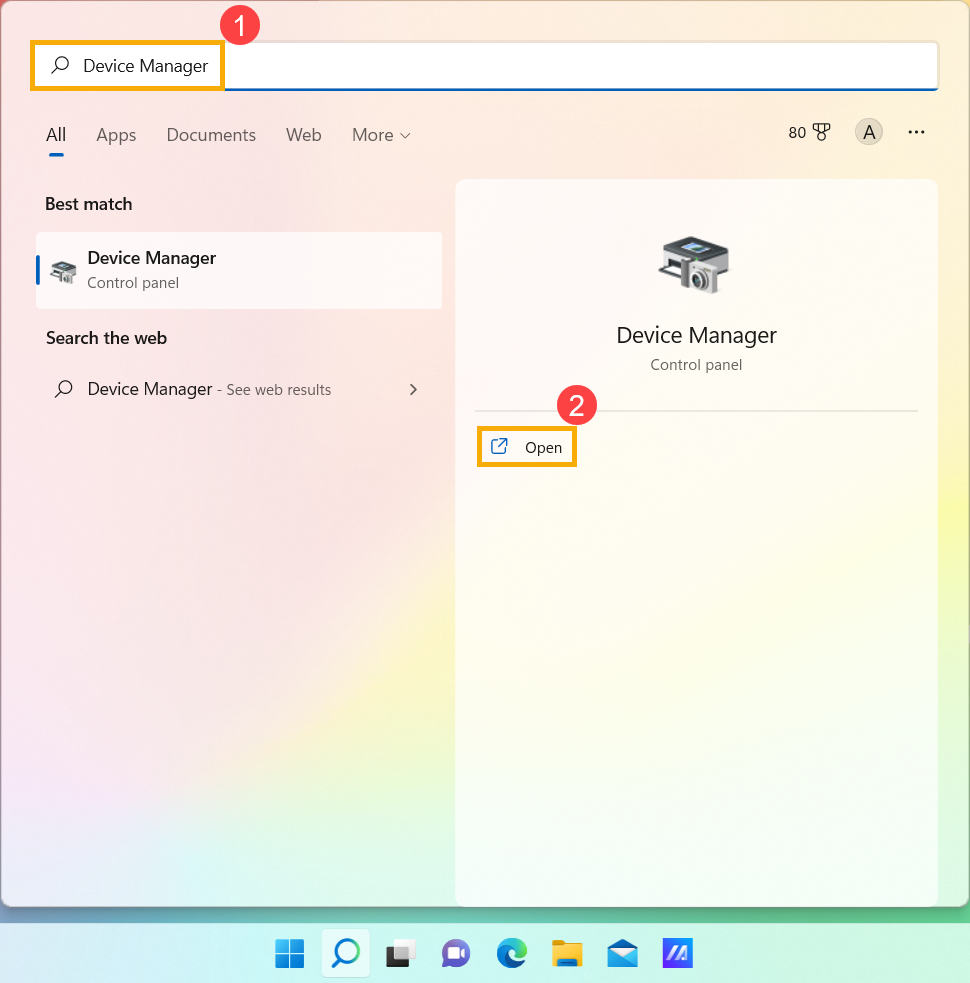
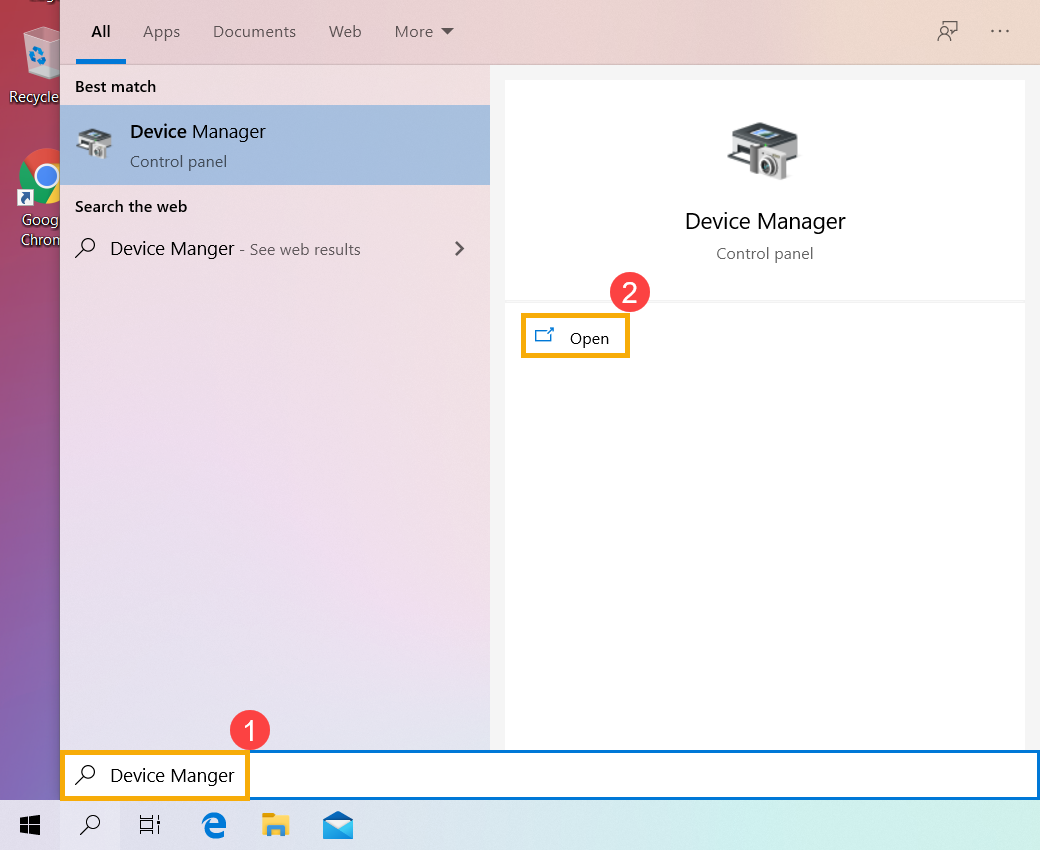
- Uninstall the driver of USB Root Hub. Check the arrow next to [Universal Serial Bus controllers]③, then right-click the [USB Root Hub]④ and select [Uninstall device]⑤.
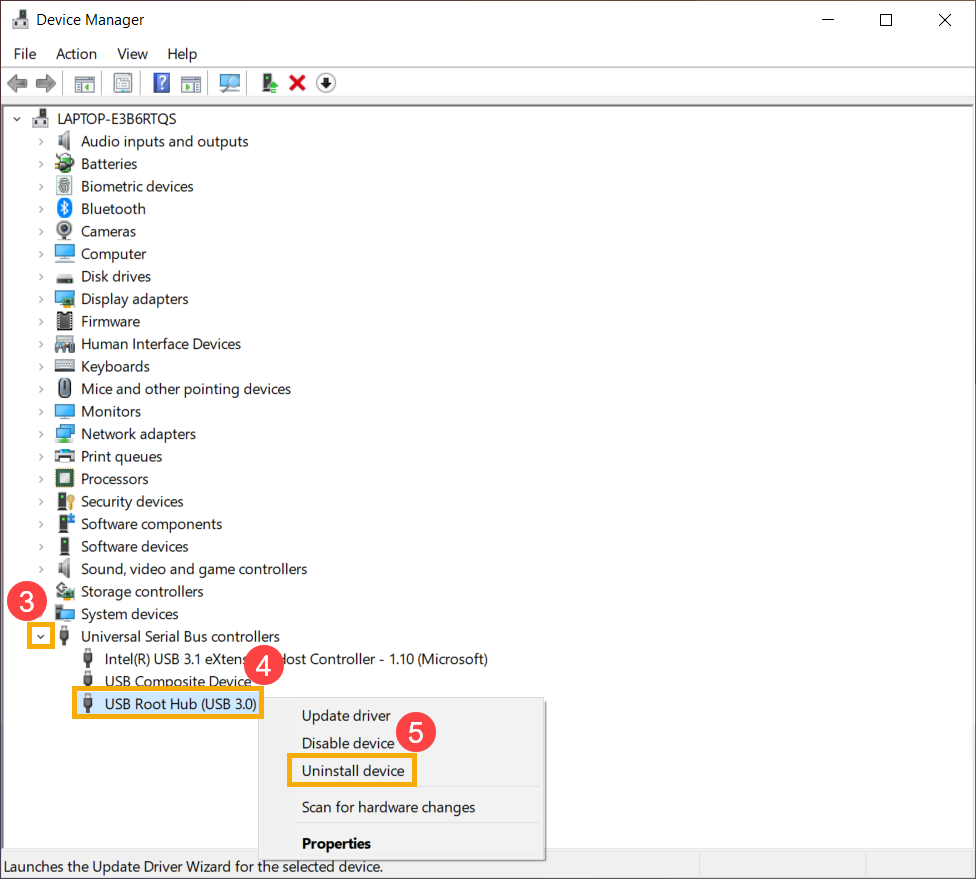
- Select [Uninstall]⑥.
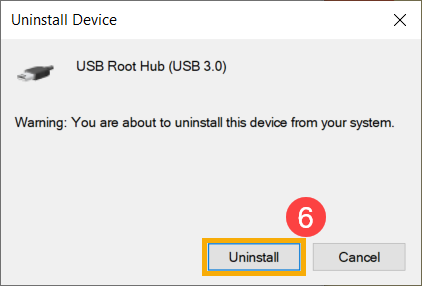
- Repeat step 3 & step 4 to uninstall all the USB Root Hubs.
Note: If your PC supports USB4, please also uninstall the USB4 Root Device Router.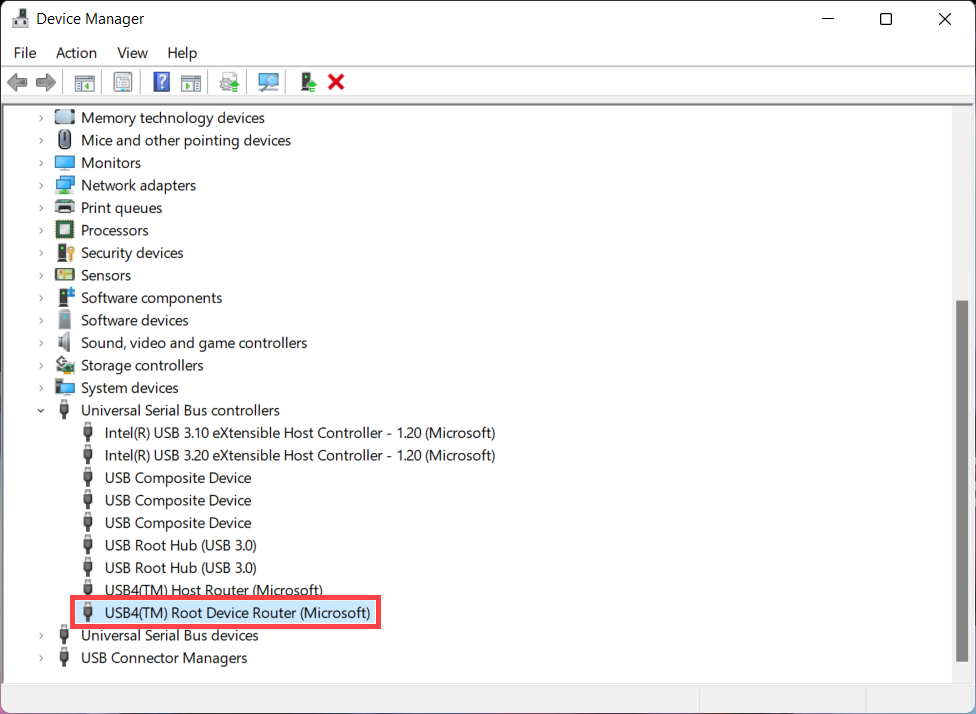
- Restart the computer. The driver will be automatically installed after the computer restarts. If problems persist, please continue to the next troubleshooting step.
Reinstall USB Host Controller driver in Device Manager
- Disconnect all USB devices from the computer.
- Type and search [Device Manager] in the Windows search bar①, then click [Open]②. (The left-side search illustration below is in Windows 11, and the right-side is Windows 10.)


- Uninstall the driver of USB Host Controller. Check the arrow next to [Universal Serial Bus controllers]③, then right-click the [USB Host Controller]④ and select [Uninstall device]⑤.
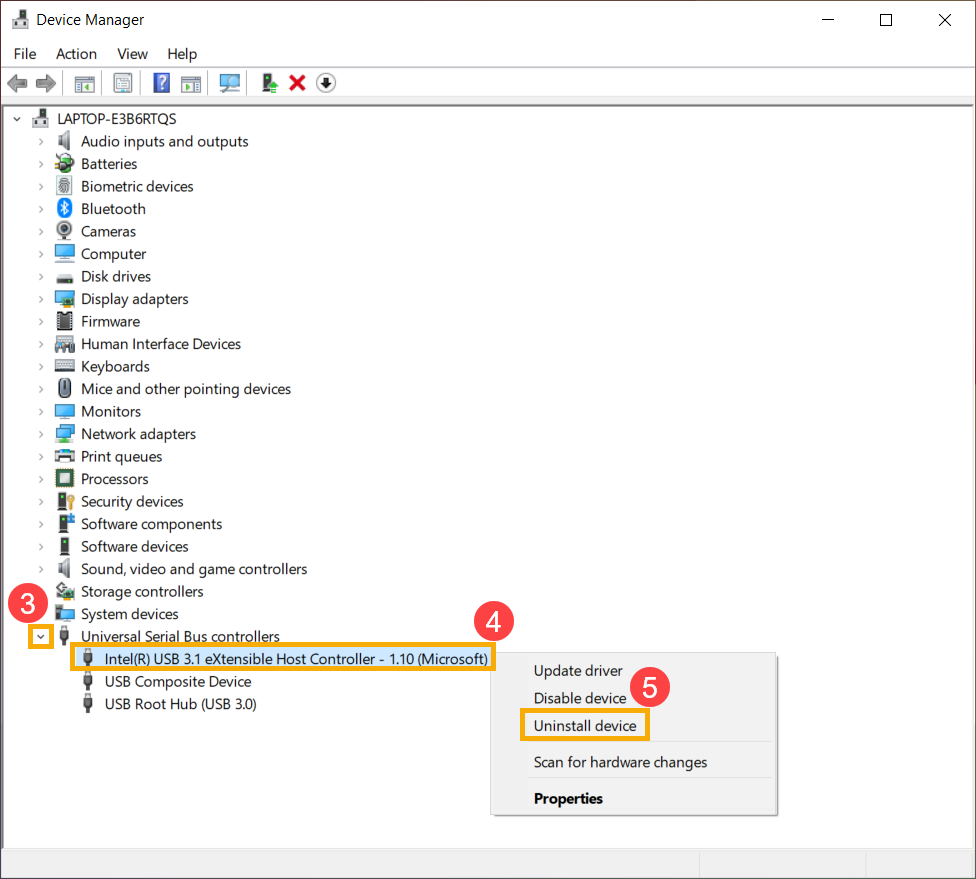
- Select [Uninstall]⑥.
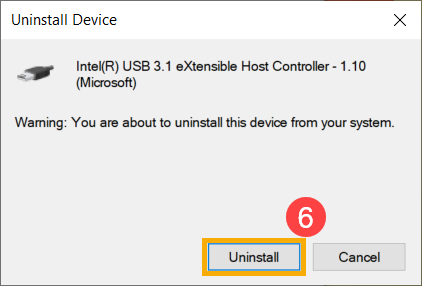
- Repeat steps 3 & step 4 to uninstall all the USB Host Controllers.
Note: If your PC supports USB4, please also uninstall the USB4 Host Router.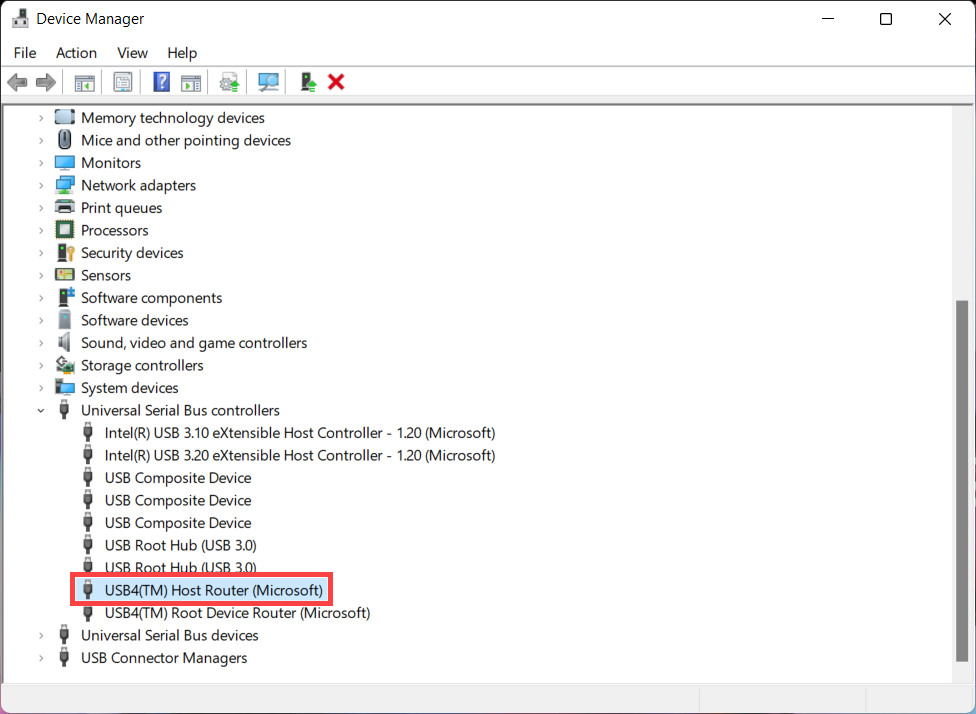
- Restart the computer. The driver will be automatically installed after the computer restarts. If problems persist, please continue to the next troubleshooting step.
Reinstall Thunderbolt driver
If your computer supports the Thunderbolt feature, try to reinstall the chipset driver. Here you can learn more about How to determine the function of USB Type-C.
- Please go to the ASUS Support site, then download and install the [Intel Chipset driver] on the Chipset category. Here you can learn more about How to search and download drivers.
Note: On most models, the Thunderbolt driver has been integrated into the Intel Chipset driver.
- After installing the driver, please restart the computer and then try to connect to Thunderbolt device. If the problem persists, please continue the next troubleshooting step.
Connect to external monitors via USB Type-C
Please make sure the USB Type-C connector on your PC whether it supports the display feature or not. Here you can learn more about How to determine the function of USB Type-C.
If USB Type-C supports the display feature, please refer to How to connect one or more external monitors.
Common solutions of USB Type-C
Refer to the suggestions of Microsoft to fix things if you get a notification that there's something wrong with the USB Type-C connection, here you can learn more about Fix USB-C problems in Windows.
If the problem persists, please continue the next troubleshooting step.
Use Restore Point to restore the system
If the USB Type-C problem happens recently, and if you have ever created a restore point or there is an automatic system restore existed, try to restore the computer to a point before the problem began to resolve the problem. Here you can learn more about How to use restore point to restore the system. If the problem persists, please continue the next troubleshooting step.
Reset the PC
If the problem persists after all troubleshooting steps are completed. Please backup your personal files, then reset the PC to back to its original configuration. Here you can learn more about How to reset the system.
If your problem is not worked out with above solution and information, please contact ASUS customer service center for further information.
